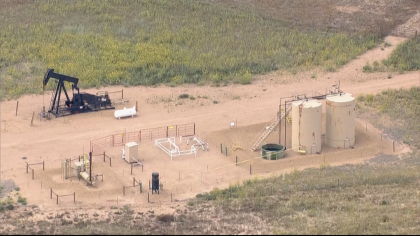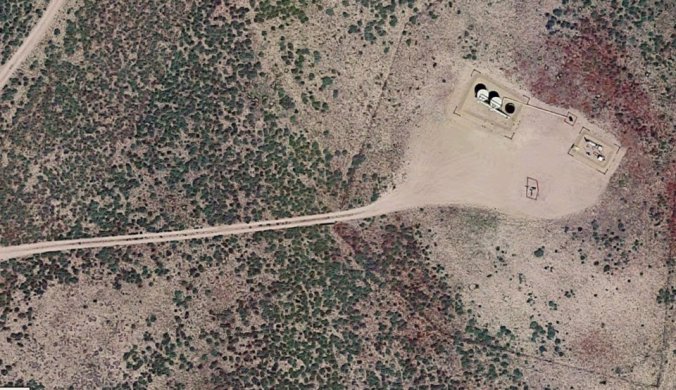Most of the glimpses we’ve gotten thus far of the CERVI 319 site have been aerial shots from news helicopters. Google Earth also provides global geographical context to the site. And it seems, with everybody watching and looking at these images, these maps, we know exactly what we’re dealing with. But while I was researching TWO FACE an elementary question arose. When Chris Watts drove to the site before dawn on August 13th, was he visible through line of sight?

Given the remote location of the site, the answer seemed to be obvious.
I wanted to make sure, however, because of something that had recently played in my mind.
An Analogy for the Importance of Line of Site
During a recent trip to the coast, I was told by some folks I was staying with about a murder that happened down the road. As it happened, I’d stayed in the house of the murdered woman months earlier when I’d gone down to attend a wedding. Because so many people were visiting that weekend, various neighbors opened their homes and I happened to stay in this ladies’ home…and then she was murdered a few months later.
So when I arrived and her murder was still unsolved, I made an effort to speak to the woman’s best friend, and visit the crime scene. Initially, I asked for directions and wandered down to the nearest beach and tried to orient myself. She had been stabbed on a staircase leading to the beach. Her blood was all over the stairs. But standing there, it didn’t make any sense. Although there were some trees blocking the view, the area was clearly visible from across the river, and especially from houses perched on a small hillside nearby. It was also right next to a roadside parking lot, a terrible place to commit murder.
It turned out I was at the wrong beach. When I went to another beach just further up the coast everything was completely different. The moment one entered the staircase, one was effectively in a downward slanting tunnel. In every direction there was no sign of human habitation. When I was there I didn’t see anyone. Not on the beach, not in the distance, not at the parking lot, not even further down the beach.
Walking along the rocky area towards the first beach where I’d mistakenly imputed the crime scene, I passed a length of jungle and rock and nothing else. And still no people. Those houses on the hillside were tucked behind the fringe of trees, so no line of site even of the beach here. And since this section of beach clipped inwards from the coast, as well as at the other end, clipped inward again, there was no line of sight from either side of the beach either.
It turned out the lady came here to walk her dog for exactly that reason – the pristine, deserted nature of the beach. She was in the habit of getting out of her car, peeking downstairs to see if anyone was there, and if the coast was clear, returning to pick up her dog, lock her car and go for her walk.
On the day of her murder [or perhaps before] the murderer picked up on this, and killed her to steal the car [which was unlocked, and still had the keys in the ignition]. Unfortunately for him, he was unable to get the car into reverse, eventually gave up, and cut and ran.
The motive seems to be straightforward. She was someone he didn’t know, and he killed her to steal her car. The difficulty in reversing theory seems far-fetched, except the best friend of the murdered lady told me she had the same car, a Suzuki SUV, and the vehicles were well-known to have reverse gear shift issues. My car sometimes does too. And getting into a strange car in a hurry, reverse sometimes simply does not engage. The nature of the parking lot was such that reverse was only way out.
What the above anecdote illustrates is the importance of characters, context and anecdotal evidence. It also shows how important it is to go to the crime scene yourself, if you can, and step into the shoes [into the psychology] of your murderer. [Incidentally, that case remains unsolved, although the woman’s phone was tracked to a shanty in a nearby informal settlement].
Line of Sight at CERVI 319
Although we feel like we know all there is to know about CERVI 319, I wanted to clarify the line of sight issue, at least in my own mind. Google Earth takes us right there, but we’re still not there on-the-ground, as it were.
From the air the CERVI site is a roughly Y-shape of cleared Earth, with the tail of the Y blowing to its left. The upper part of the Y-shaped site rests at a slight angle inside a rectangular corridor.

On either side of this cleared area are brown rocks, and speckles of green bushes peppering the landscape. This was my best guess that the contours of the area dipped down, and that CERVI 319 is situated in a depression within a shallow valley amongst low hills. But the question remained: how shallow was this valley?
The service road nearby would be Chris Watts’ biggest concern. Could random strangers peek into or over the site while he was rushing about barefoot trying to get rid of three bodies?
The Denver Post provides this unusual in situ shot of the site. Notice the power line to the right appears to correspond with to the Google Earth screengrab.

And according to the caption, the oil site is near Roggen. That puts us in the ballpark too.

The Denver Post doesn’t identify the image as the actual work site, but what it does do is locate the local topography from an on-the-ground perspective.
It’s clear that there are undulating hills in the area and a small amount of brush. These hills are higher and steeper than I’d perceived them to be from the satellite images. This confirms the CERVI 319 site must have been secluded in line of sight terms by the surrounding hills.

ROGGEN, CO – AUGUST 21: According to Christopher Watts’ arrest affidavit, Shanann Watts’ body was found in a shallow grave near this oil work site, seen here on August 21, 2018 near Roggen, Colorado. Both of her daughter’s bodies, 4-year-old Bella and 3-year-old Celeste, were submerged for days in the same oil tanks in rural eastern Colorado, prosecutors said. (Photo by RJ Sangosti/The Denver Post)
